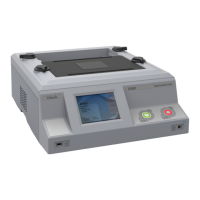C H A P T E R 7 – T E S T S A N D T E S T C O N D I T I O N S
AT5600 User Manual 98-119 issue 14 Page 96
three levels of integration Short, Medium, and Long. The following table shows
the relative standard error corresponding to each integration level:
As a guide to which integration level to set, consider the tolerance that is being set
for each measurement.
For example, consider the R test for a winding of 11.3 ohms nominal, that has an
expected value of 10.8 ohms, and the upper limit of the test set to 12 ohms.
The uncertainty that the measurement must be made to must be less than
100 * (12 - 11.3) / 11.3 = 6.2%.
For margin, the integration level should be chosen for a relative standard error of
no more than half of the uncertainty-in this case short integration should be
chosen as its relative standard error is much less than half of the uncertainty
required.
On the other hand, consider measurement of the Q factor of an inductor with an
actual Q of 110: -
The value of Rs represents 1 / 110 = 0.909% of the impedance of the inductor.
If the minimum Q that is acceptable is 100, then Rs must be measured to better
than 100* (110 - 100) / 100 = 10% of its nominal value; the uncertainty of the
measurement must be less than 0.909% * 10% = 0.0909%. In this case, it is clear
that long integration should be chosen.
For production testing, test limits are usually sufficiently wide to allow short (and
occasionally medium) integration to be chosen, and this will result in the shortest
possible test times.

